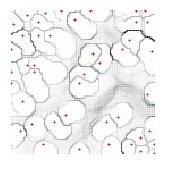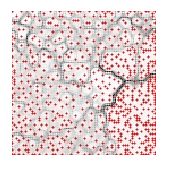Today I gave a presentation about the "Internet of Things" at a foresight meeting in Geneva.I spoke after Lara Srivastava from the ITU who described the ITU's vision about that topic. In my talk, I tried to show an alternative vision, as propelled by artists or researchers. My point was to show through various projects how the Internet of Things can be described: locative media as first incarnation, visualizations of networked communication and above all blogjects.
Notes from Sami Coll's presentation about a sociological perspective on the Internet of Things:
- nowadays, we leave lots of traces (fidelity cards, credit card transactions, cell phone usage...)
- sometimes it's possible to access to these traces (it's even possible in Switzerland with supermarket cards)
- use of traces: marketing, digital marketing, amazon's propositions... list pirates/terrorists, fight against social abusers
- "savoir c'est pouvoir" ("knowing, it's exerting power")
two faces of the same coin:
- convenient technologies
- "technologies of surveillance": leave traces in the daily experience of users, produce very valuable information. this secondary function is not always conscious to the users.
paradox: we've never give a so important value to individualism (technologies aim at making people free) BUT the individuals have never been tracked that way... production of a new type of knowledge about people.
this paradox is very important with regards to consumption practices: liberty but it's also the place in which we produced the most important amount of information.
traditionally, people are very reluctant towards the State (the price to pay so that it can guarantee different things?)
laws (the point in Switzerland = data belongs to whom they concern)
transparency and access to the owner
right to ask their suppression
and people have the responsibility to protect oneself
BUT this responsibility depends upon the sociocultural categories
and even when it's perceived this potential of surveillance is not seen as dangerous ("I don't have anything to hide so there is no problem" as Sami's studies showed)
and very individualist approach
however...a fact should be acknowledged: modern societies need surveillance
surveillance started in 18th century: how to maintain a social order with the demographic explosion (mad people, criminals... prisons...)
then in 19-20th century: industrial revolution: surveillance of factories, workers... to optimize production
20-21th century: new problem = we produce more than we consume, then a necessity to exert control on people so that they consume more (ad...growth).
surveillance now concerns everyone of us
our daily life in the Internet of things?
less "spaces" that are not under control
we will leave more traces in places that will be more intimate
it will allow to optimize our life (maximize the profit, minimize losses)
do we really need all those technologies and produce all those information to be more free?
from what should we be more free?
isn't it a way to create a new type of individuals?
Then Olivier Liechti presented some more concrete elements, using great examples such as the life of cows and RFID usage. What attracted me in his presentation was this:
RFID exists for 50 years so why do everyone talk about it nowadays?
- standardization (legal obligation + commercial reasons such as Wal Mart asked its suppliers to use them
- higher/increasing volume
- interoperability
- new applications and technologies (sensor networks...)
- their cost went down
- globalization (use this information in all steps of the supply chain















 Why do I blog this? a friend of mine in the game design industry used it today in a presentation about successful transfer from the academic world to the industry (especially game designers).
Why do I blog this? a friend of mine in the game design industry used it today in a presentation about successful transfer from the academic world to the industry (especially game designers).